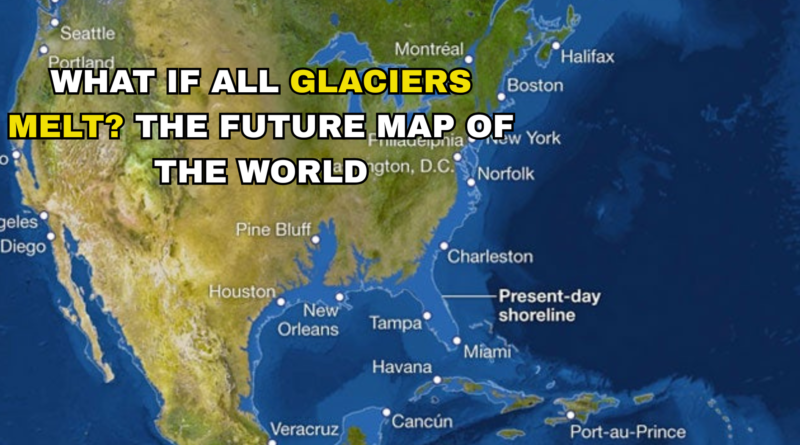WHAT IF ALL GLACIERS MELT? THE FUTURE MAP OF THE WORLD
Glaciers are giant blocks of ice found on mountains and in polar regions like Antarctica and Greenland. They store about 70% of Earth’s fresh water. Today, because of climate change, many glaciers are melting faster than before. But what if one day all glaciers on Earth melted completely? This would bring massive changes to our planet. The future map of the world would not look the same.
Rising Sea Levels
If every glacier melted, scientists estimate that sea levels could rise by around 65–70 meters (over 200 feet). This is enough to swallow thousands of coastal cities, islands, and even entire countries. Major cities like New York, London, Mumbai, Shanghai, and Sydney would go underwater. Low-lying countries such as the Maldives, Bangladesh, and the Netherlands could completely disappear.
The map of the world would show fewer coastlines and more ocean. Asia, Africa, and South America would lose huge areas of land near their shores. North America and Europe would shrink as their coastal regions vanish into the sea.
Disappearing Countries and New Borders
The melting of glaciers would redraw political maps. Countries that depend on coastal cities for trade, population, and culture would be forced to move inland. For example:
India could lose big cities like Kolkata, Chennai, and Mumbai.
China would lose Shanghai, Guangzhou, and much of its eastern coast.
The United States would lose New York, Florida, and California’s coastal areas.
Europe would see Venice, Amsterdam, and London underwater.
Many small island nations would no longer exist. New maps would have blank spaces where entire countries once stood. At the same time, inland regions might become more crowded as people escape from drowned coastlines.
Mass Migration and Climate Refugees
With sea levels rising, billions of people would need to move. Scientists call these people climate refugees. Imagine entire populations of cities being forced to abandon their homes. Countries in the middle of continents, such as Russia, Canada, and central African nations, would see a huge increase in migrants.
This would cause social, political, and economic pressure. Governments would struggle to provide food, water, jobs, and shelter for so many new people. Conflicts between nations might grow as they fight over safe land and resources.
Fresh Water Shortages
Glaciers are not just frozen water; they are natural storage tanks that feed rivers and lakes. When glaciers melt completely, many rivers would dry up. Famous rivers like the Ganges, Indus, Yangtze, and Colorado depend on glacier water. Without them, billions of people would face drinking water shortages.
Farmers who rely on rivers for irrigation would struggle to grow food. Countries with already dry climates, such as those in the Middle East and Africa, would face severe droughts.
Changes in Weather and Climate
Glaciers help keep Earth’s climate balanced. They reflect sunlight, keeping the planet cool. Without them, the Earth would absorb more heat, raising global temperatures even more. This could create stronger storms, heat waves, and unpredictable weather patterns.
Rising oceans would also change ocean currents, which control global climate. For example, the Gulf Stream in the Atlantic Ocean might weaken or stop, making Europe much colder while other regions become hotter.
New Oceans and Lakes
As glaciers melt, new seas and lakes would appear. For example:
Large parts of Antarctica would turn into open water.
The Greenland ice sheet would melt, creating inland seas.
Low-lying deserts could fill with water, becoming new inland seas or lakes.
The map of the world would show completely new water bodies that do not exist today.
Wildlife and Ecosystems at Risk
Animals that depend on glaciers and cold weather, such as polar bears, penguins, and seals, would lose their habitats. Many could go extinct. Fish and marine animals would also be affected because melting glaciers add fresh water to the salty oceans, changing their chemistry. Coral reefs, which are already threatened, would suffer even more from rising temperatures and higher sea levels.
Forests and grasslands would also shift. Some regions would become too hot for certain plants, while others might become wetter or drier. The natural balance of ecosystems would break, affecting human food supplies as well.
Human Civilization in Danger
The melting of all glaciers would not just redraw the world map; it would shake the foundation of human civilization. Cities, ports, farms, and industries built over thousands of years would be destroyed. Millions of cultural landmarks, temples, and heritage sites would vanish underwater.
Economies would collapse as trade routes sink and farmland disappears. People would need to invent new ways to survive—building floating cities, living in artificial domes, or even moving to higher mountains.
Can This Be Prevented?
The good news is that glaciers are melting slowly, not overnight. We still have time to reduce the damage. Cutting greenhouse gas emissions, using renewable energy, planting forests, and protecting nature can slow down global warming. If we act responsibly, we can save many glaciers and reduce sea level rise.




